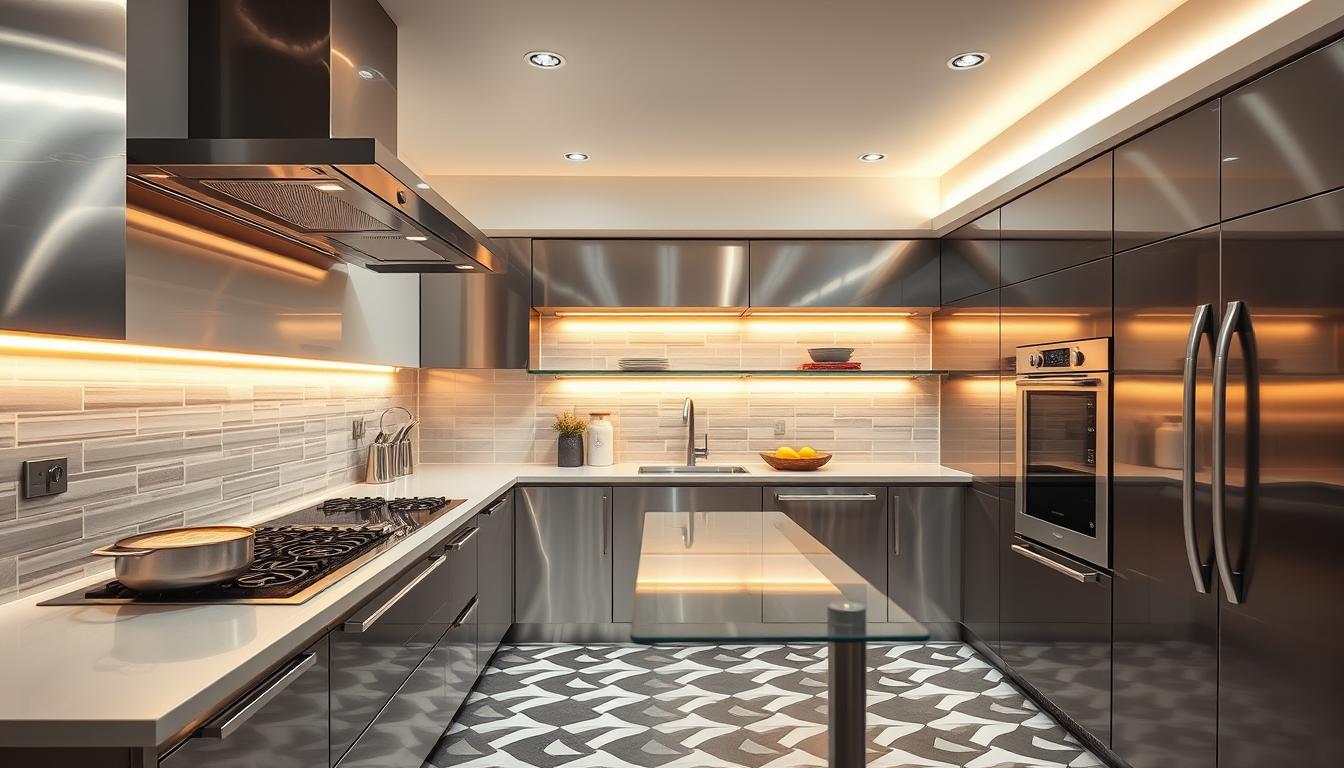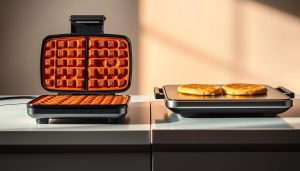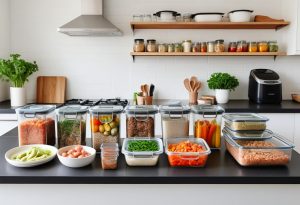Your kitchen faces more fire risks than any other room, with stovetops and ovens generating temperatures exceeding 500°F. Modern cooking spaces combine intense heat sources, electrical appliances, and flammable oils – a recipe for potential disaster that demands smart surface solutions.
Heat-resistant surfaces transform danger zones into secure cooking environments. Stainless steel backsplashes deflect flames, while tempered glass countertops withstand sudden temperature changes. These solutions blend safety with sleek aesthetics, proving protection doesn’t require sacrificing style.
Renovations now prioritize surfaces that combat flare-ups without constant maintenance. Ceramic tiles create firebreaks near cooking stations, and stone countertops resist scorch marks from hot pans. Proper material selection reduces fire spread speed by up to 70%, giving crucial extra minutes for emergency response.
Key Takeaways
- Cooking equipment causes nearly half of all residential fires annually
- Heat-resistant surfaces reduce fire risks while maintaining visual appeal
- Strategic material choices can slow fire spread by significant margins
- Modern options combine safety with easy maintenance and cleaning
- Proper installation creates layered protection around heat sources
- Durable solutions maintain property value and insurance compliance
Introduction to Fireproof Materials in the Kitchen
Every year, over 170,000 kitchen fires erupt in U.S. homes, turning culinary spaces into danger zones. High heat from stoves, grease splatters, and electrical malfunctions create risks that demand proactive solutions. Protective surfaces form invisible shields around cooking areas, balancing safety with daily functionality.

Why Your Space Needs Protection
Open flames and overheated appliances can ignite nearby items in seconds. Non-combustible surfaces act as barriers, slowing flame spread by up to 50%. This critical defense gives you time to react during emergencies while protecting cabinetry and walls from scorch damage.
Triple-Layer Advantages
Modern protective options deliver three core benefits. First, they resist temperatures exceeding 1,000°F without warping. Second, scratch-resistant finishes handle daily meal prep. Third, sleek finishes like matte metallics or textured stone integrate seamlessly with modern decor.
Homeowners gain lasting value through reduced repair costs and insurance premium discounts. Many states now require specific fire-rated surfaces near heat sources during renovations, making these upgrades both practical and code-compliant.
Key Features and Benefits of Fireproof Materials
Modern cooking spaces now integrate surfaces that do double duty – stopping flames in their tracks while elevating your kitchen’s visual appeal. These solutions combine cutting-edge engineering with design flexibility, creating layers of protection that work silently behind stylish facades.

Enhanced Fire Resistance and Durability
Premium options resist scorching temperatures without igniting or releasing harmful fumes. Granite countertops, for example, handle direct heat from pans while maintaining their polished look. Quartz surfaces offer similar resistance, though their resin content requires careful placement away from open flames.
Stainless steel backsplashes demonstrate exceptional durability, bouncing back from splatters and scorch marks. Their non-porous nature prevents grease absorption – a common fire accelerant. You’ll find these surfaces retain their structural integrity even after years of high-heat exposure.
Improved Aesthetic Appeal and Easy Maintenance
Today’s protective surfaces shatter the myth that safety means sacrificing style. Textured ceramic tiles come in jewel tones that pop against neutral cabinetry, while tempered glass panels create sleek, reflective accents. Matte-finish options hide fingerprints better than traditional polished metals.
Cleaning becomes effortless with stain-resistant coatings that repel oil and food particles. A simple wipe-down maintains surfaces like quartz or treated stone, eliminating the need for harsh chemicals. These low-maintenance properties save time while keeping your space code-compliant and visually sharp.
Fireproof Materials for Kitchen Use – Buyer’s Guide Tips
Selecting the right protective surfaces transforms your cooking area into a safer space without compromising on design. Focus on solutions that align with your cooking habits, maintenance preferences, and local building codes.

Essential Factors to Consider When Choosing Materials
Start by matching heat resistance to your appliances’ output. Gas burners and pizza ovens often exceed 500°F – your surfaces must handle these temperatures without warping. Check product labels for ASTM fire ratings and UL certifications.
Maintenance needs vary widely between materials. Porous stone requires sealing every 6 months, while stainless steel wipes clean instantly. Consider your available time for upkeep when comparing options.
| Material Type | Max Heat Tolerance | Maintenance Level | Aesthetic Flexibility |
|---|---|---|---|
| Stainless Steel | 1,200°F | Low | Modern/Industrial |
| Tempered Glass | 900°F | Medium | Contemporary |
| Ceramic Tile | 600°F | High | Traditional |
Balance initial costs against long-term value. While stone surfaces have higher upfront prices, their 30+ year lifespan often justifies the investment. Verify local safety standards for required clearances around heat sources.
Finally, ensure proper sizing and installation. Measure your workspace carefully – gaps between panels create fire vulnerabilities. Many manufacturers offer custom-cut pieces for tricky layouts.
Material Options and Applications in Modern Kitchens
Contemporary cooking spaces demand surfaces that balance protection and visual harmony. The right selections create invisible shields against heat while complementing your decor. Let’s explore solutions that meet both safety and style needs.

Popular Fireproof Materials: Stainless Steel, Glass, Ceramic, and Stone
Stainless steel dominates commercial spaces for good reason. Its non-porous surface repels grease and handles direct flame contact. You’ll often find it wrapping ventilation hoods or forming seamless countertops in high-heat zones.
Kiln-fired ceramic tiles bring versatility to backsplashes and flooring. Their manufacturing process creates inherent resistance to flames, available in patterns mimicking wood or marble. Pair them with glass accents for reflective surfaces that expand visual space.
Natural stone options like granite and slate offer unique veining alongside thermal stability. These slabs work particularly well as statement islands or hearth-like surrounds. For industrial flair, consider polished concrete countertops with integrated heat barriers.
Integrating Safety with Contemporary Kitchen Design
Modern aesthetics thrive through strategic material pairings. Combine matte-finish steel appliances with textured stone walls for depth. Use glass cabinet inserts to showcase dishware while maintaining firebreaks between cooking and storage areas.
Metal accents extend beyond functionality. Copper range hoods develop patinas over time, adding character while blocking flames. Aluminum paneling creates sleek, monochromatic looks in minimalist spaces. These choices prove protective materials can elevate rather than limit design possibilities.
Lighting plays a crucial role in showcasing these elements. Position LED strips under stone overhangs or behind ceramic tile features. The result? A space where safety measures become integral to the room’s visual narrative.
Installation, Maintenance, and Compliance With Safety Standards
Proper setup transforms protective surfaces from decorative elements into active safety barriers. Strategic placement and material care ensure long-term performance while meeting legal obligations. Let’s explore how to maximize effectiveness through correct practices.
Best Practices for Installation and Local Code Considerations
Start by reviewing your local building codes for clearance requirements around stoves and ovens. Many jurisdictions mandate specific insulation types or minimum distances between heat sources and combustible walls. Professionals often use fire-rated drywall behind ranges to slow flame spread.
Heat-resistant adhesives prevent tiles from loosening under extreme temperatures. Allow 1/8-inch gaps between materials for expansion during heating cycles. Ventilation channels behind backsplashes reduce heat buildup that could damage underlying structures.
| Code Requirement | Residential Standard | Commercial Standard |
|---|---|---|
| Wall Clearance | 12-24 inches | 36 inches |
| Ventilation Openings | 1 sq ft per 150 CFM | 1 sq ft per 100 CFM |
| Heat Shield Thickness | 0.024″ metal | 0.040″ metal |
Clean surfaces weekly with mild soap and water to prevent grease accumulation. Avoid abrasive cleaners that create micro-scratches where stains can form. Inspect seams annually for gaps that might compromise safety barriers.
Store rollable materials in climate-controlled areas to prevent warping. Lay rigid sheets flat on padded surfaces to avoid cracks. Always verify manufacturer guidelines for handling specialty metal or composite panels.
Conclusion
Choosing the right surfaces can turn your cooking area into a fortress against flames without sacrificing aesthetics. Fire-resistant solutions blend advanced protection with modern design, creating spaces that are both safe and visually appealing. From stainless steel to natural stone, these options prove safety enhancements can elevate your kitchen’s durability and style.
You gain lasting value through reduced maintenance needs and potential insurance advantages. Proper installation following local safety standards ensures maximum effectiveness, while regular inspections maintain fire resistance over time. Always prioritize manufacturer guidelines for cleaning to preserve protective properties.
Modern homes benefit most when materials work behind the scenes. They create invisible shields against heat damage while complementing your decor. This smart approach to kitchen design offers peace of mind, knowing your space combines beauty with crucial safeguards.



